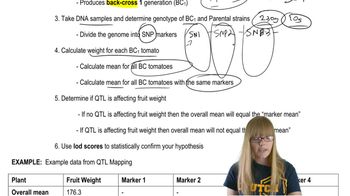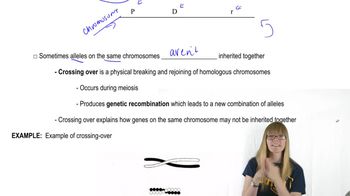True or False:Association (GWA) mapping definitively proves that the gene identified is responsible for the trait variation or phenotype?
Table of contents
- 1. Introduction to Genetics51m
- 2. Mendel's Laws of Inheritance3h 37m
- 3. Extensions to Mendelian Inheritance2h 41m
- 4. Genetic Mapping and Linkage2h 28m
- 5. Genetics of Bacteria and Viruses1h 21m
- 6. Chromosomal Variation1h 48m
- 7. DNA and Chromosome Structure56m
- 8. DNA Replication1h 10m
- 9. Mitosis and Meiosis1h 34m
- 10. Transcription1h 0m
- 11. Translation58m
- 12. Gene Regulation in Prokaryotes1h 19m
- 13. Gene Regulation in Eukaryotes44m
- 14. Genetic Control of Development44m
- 15. Genomes and Genomics1h 50m
- 16. Transposable Elements47m
- 17. Mutation, Repair, and Recombination1h 6m
- 18. Molecular Genetic Tools19m
- 19. Cancer Genetics29m
- 20. Quantitative Genetics1h 26m
- 21. Population Genetics50m
- 22. Evolutionary Genetics29m
20. Quantitative Genetics
QTL Mapping
Problem 20a
Textbook Question
Many traits of economic or medical significance are determined by quantitative trait loci (QTLs) in which many genes, usually scattered throughout the genome, contribute to expression.
What general procedures are used to identify such loci?
 Verified step by step guidance
Verified step by step guidance1
Understand the concept of quantitative trait loci (QTLs): QTLs are regions of the genome that are associated with the variation of a quantitative trait, such as height, weight, or disease susceptibility. These traits are typically influenced by multiple genes and environmental factors.
Perform a genetic cross: Begin by crossing two parental strains that differ significantly in the quantitative trait of interest. This generates offspring with varying phenotypes, which can be analyzed to identify genetic contributions to the trait.
Genotype the offspring: Use molecular markers, such as single nucleotide polymorphisms (SNPs) or microsatellites, to determine the genetic makeup of the offspring at various loci across the genome.
Perform statistical analysis: Use linkage analysis or association mapping to correlate the genotypic data with the phenotypic variation observed in the offspring. This helps identify regions of the genome that are significantly associated with the trait.
Validate and refine QTLs: Conduct further experiments, such as fine mapping or functional studies, to narrow down the identified loci and confirm their role in influencing the quantitative trait.
 Verified video answer for a similar problem:
Verified video answer for a similar problem:This video solution was recommended by our tutors as helpful for the problem above
Video duration:
2mPlay a video:
Was this helpful?
Key Concepts
Here are the essential concepts you must grasp in order to answer the question correctly.
Quantitative Trait Loci (QTL)
Quantitative Trait Loci (QTL) are specific regions of the genome that are associated with the variation in a quantitative trait, which is a trait that can be measured and expressed numerically, such as height or blood pressure. QTLs typically involve multiple genes, each contributing a small effect to the overall phenotype. Understanding QTLs is crucial for identifying genetic factors that influence complex traits in both plants and animals.
Recommended video:
Guided course

QTL Mapping
Genetic Mapping
Genetic mapping is a method used to determine the location of genes on a chromosome and the distances between them. This process often involves creating a genetic linkage map using markers, such as single nucleotide polymorphisms (SNPs), to identify regions of the genome that correlate with specific traits. Accurate genetic mapping is essential for pinpointing QTLs and understanding their role in trait variation.
Recommended video:
Guided course

Mapping Overview
Statistical Analysis in QTL Mapping
Statistical analysis plays a vital role in QTL mapping by helping researchers determine the significance of the association between genetic markers and traits. Techniques such as ANOVA, regression analysis, and mixed models are commonly used to analyze phenotypic data in relation to genotypic data. These analyses help to identify which QTLs are likely to be responsible for observed trait variations, guiding further research and applications in breeding and medicine.
Recommended video:
Guided course

QTL Mapping
Related Videos
Related Practice
Multiple Choice
376
views
2
rank


